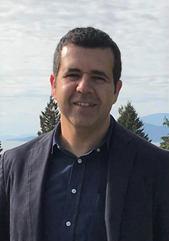Phononics at the crossroads with fluid dynamics and heat transfer
| When: | Th 07-07-2022 13:30 - 15:00 |
| Where: | 5161.0165 |
Abstract
Phononics is an emerging field that seeks to elucidate the nature of intrinsic mechanical motion in both conventional and artificially structured materials, and use this knowledge to extend the boundaries of physical response at either the material or structural/device level or both. The field bridges multiple disciplines across applied physics and engineering, and spans multiple scales reaching the atomic scale where a rigorous definition of phonons resides–quanta of lattice vibrations. In this talk, I will present two distinct contributions of phononics, one to the classical field of fluid dynamics and the other to the emerging field of nanoscale heat transfer.
Flow control is a many-decades old engineering problem that is concerned with devising passive or active means of intervention with the flow structure and its underlying mechanisms in a manner that causes desirable changes in the overall flow behaviour. For streamlined bodies cruising through a flow, such as air, there has been a particular interest in the control of flow instabilities as a means to delay laminar-to-turbulent transition, and hence reduce skin-friction drag. A reduction in drag improves the fuel efficiency. In collaborative work with Professor Sedat Biringen, we have shown that “phonon” motion underneath a surface interacting with a flow may be tuned to cause the flow to stabilize, or destabilize, as desired [1].
The underlying control mechanism utilizes two core concepts from phononics, namely, the principle of destructive interferences and the notion of symmetry breaking. This approach represents an unprecedented capability to passively synchronize wave propagation across the interface of a structure and a flowing fluid, and achieve favourable, and predictable, alterations to the flow properties. In this seminar, I will present this new theory of flow control and demonstrate its effectiveness using coupled fluid-structure simulations in a channel flow retrofitted with a
phononic subsurface (PSub).
In the realm of nanoscale heat transfer, I will present the concept of a locally resonant nanophononic metamaterial (NPM) [2], of which one realization is a freestanding silicon membrane (thin film) with a periodic array of nanoscale pillars extruding out of one or both free surfaces. Heat is transported along the membrane portion of this nanostructured material as a succession of wavenumber-dependent propagating vibrational waves, phonons. The atoms making up the minuscule pillars, on their part, generate wavenumber-independent resonant vibrational waves, which we describe as vibrons. These two types of waves linearly interact causing a mode coupling for each pair which appears as an avoided crossing in the pillared membrane’s phonon band structure. This in turn (1) enables the generation of new modes localized in the nanopillar portion(s) and (2) reduces the base membrane phonon group velocities around the coupling regions.
These effects bring rise to a unique form of transport through the base membrane, namely, resonant thermal transport. The in-plane thermal conductivity decreases as a result. I will introduce the concept of an NMP and present thermal conductivity predictions using lattice-dynamics calculations and molecular dynamics simulations. Finally, the potential for this concept to produce high-efficiency thermoelectric energy conversion will be discussed and demonstrated.
[1] Hussein, M.I., Biringen, S., Bilal, O.R., and Kucala, A. “Flow stabilization by subsurface phonons,”
Proceedings of the Royal Society A, 471, 20140928, 2015.
2] Davis, B.L. and Hussein, M.I., “Nanophononic metamaterial: Thermal conductivity reduction by local
Short Bio: Mahmoud I. Hussein is the Alvah and Harriet Hovlid Professor at the Smead Department of Aerospace Engineering Sciences at the University of Colorado Boulder. He holds a courtesy faculty appointment in the Department of Physics and an affiliate faculty appointment in the Department of Applied Mathematics. He received a BS degree from the American University in Cairo (1994) and MS degrees from Imperial College, London (1995) and the University of Michigan‒Ann Arbor (1999, 2002). In 2004, he received a PhD degree from the University of Michigan, after which he spent two years at the University of Cambridge as a postdoctoral research associate.
Dr. Hussein’s research focuses on the dynamics of materials and structures, especially phononic crystals and metamaterials, at both the continuum and atomistic scales. His research considers areas that range from vibrations and acoustics of engineering structures and passive flow control to lattice dynamics and thermal transport in semiconductor-based nanostructured materials. His studies are concerned with physical processes governing these systems, associated theoretical and computational treatments, and analysis of relevant phenomena such as dispersion, resonance, dissipation, and nonlinearity. His team also conducts experiments to support some aspects of the theoretical work.
Dr. Hussein received a DARPA Young Faculty Award in 2011, an NSF CAREER award in 2013, and in 2017 was honored with a Provost’s Faculty Achievement Award for Tenured Faculty at CU Boulder. He has co-edited a book titled Dynamics of Lattice Materials published by Wiley. He is a Fellow of ASME and has served as an associate editor for the ASME Journal of Vibration and Acoustics. In addition, he is the founding vice president of the International Phononics Society and has co-established the Phononics 20xx conference series which is widely viewed as the world’s premier event in the emerging field of phononics.
resonance,” Physical Review Letters 112, 055505, 2014.

